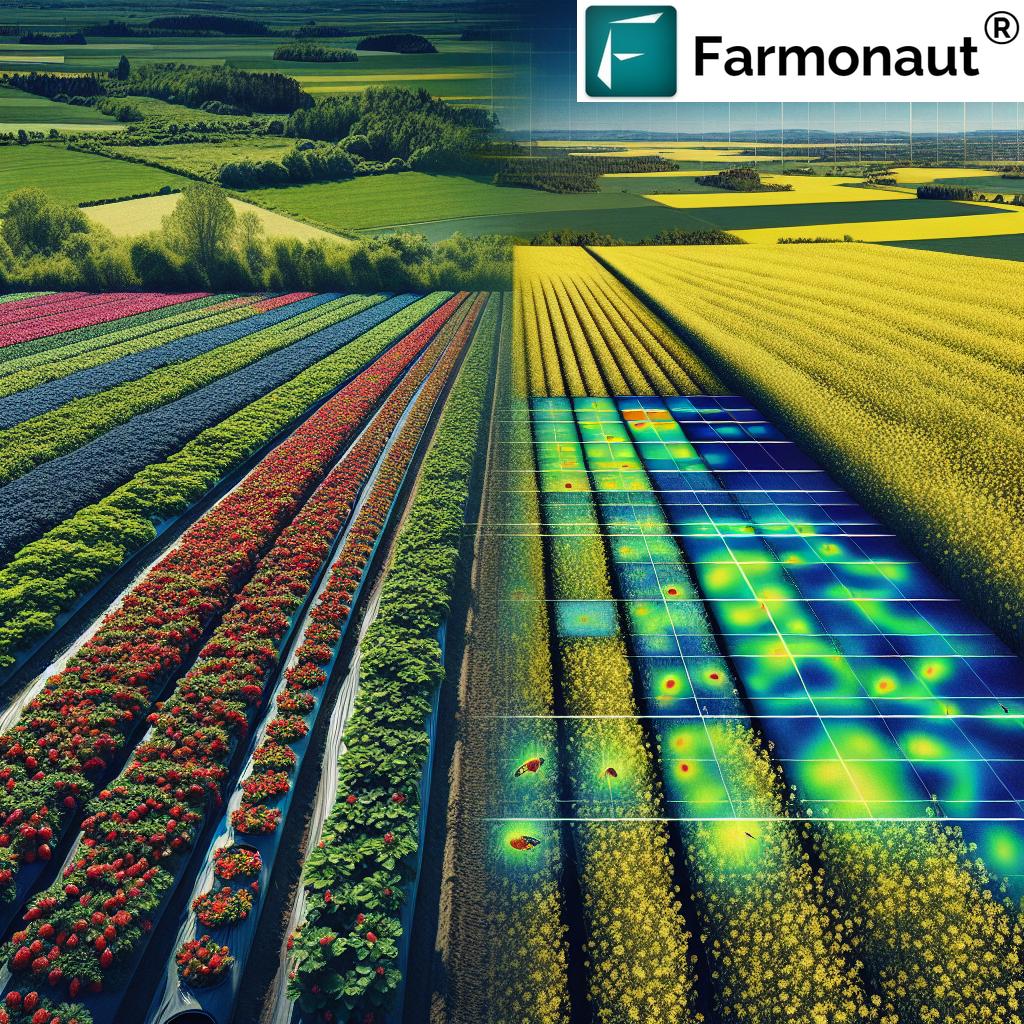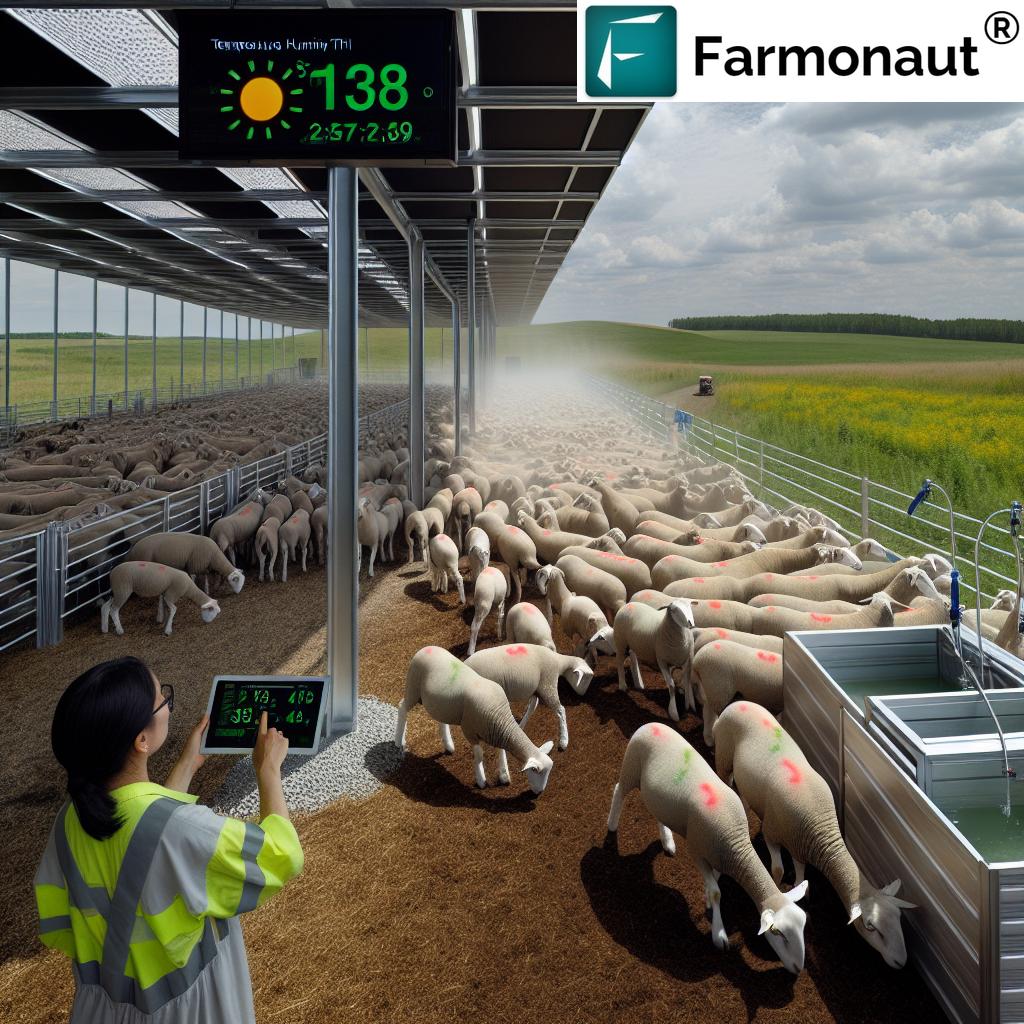LeafHope: Revolutionizing Sustainable Agriculture in Canada – Reducing Insecticide Use in Berry and Canola Farming
“The LeafHope project aims to revolutionize pest management in a $31 billion berry and canola industry across multiple Canadian provinces.”
In the ever-evolving landscape of Canadian agriculture, we are witnessing a groundbreaking initiative that promises to transform the way we approach pest management and crop protection. The LeafHope project, a collaborative agricultural research endeavor, is at the forefront of this revolution, focusing on reducing insecticide use while maintaining high yields in strawberries, blueberries, and canola crops. As we delve into the intricacies of this project, we’ll explore how it’s shaping the future of sustainable agriculture in Canada and beyond.
Understanding the LeafHope Project
The LeafHope project is a comprehensive initiative that spans multiple Canadian provinces, including Ontario, Québec, and Alberta. Its primary objective is to address the challenges posed by climate change on insect behavior and crop health, particularly in the berry and canola farming sectors. By employing cutting-edge agricultural technology for pest control and focusing on leafhopper monitoring in crops, the project aims to revolutionize pest management strategies.
At its core, LeafHope is about striking a balance between agricultural productivity and environmental stewardship. The project recognizes the critical need to reduce our reliance on synthetic pesticides while ensuring that farmers can still protect their crops and maintain economic viability.
The Significance of Berry and Canola Farming in Canada
Before we dive deeper into the LeafHope project, it’s essential to understand the economic importance of berry and canola farming in Canada. These crops collectively contribute to a $31 billion industry, playing a crucial role in the country’s agricultural sector and economy at large.
- Strawberries: A popular fruit crop with significant economic value, particularly in Ontario and Québec.
- Blueberries: Canada is one of the world’s largest producers of blueberries, with wild and cultivated varieties contributing to export markets.
- Canola: A major cash crop in Canada, particularly in Alberta, used for cooking oil production and biodiesel.
Given the economic significance of these crops, any improvements in their cultivation methods can have far-reaching impacts on the Canadian agricultural landscape.

The Challenge: Balancing Crop Protection and Environmental Sustainability
One of the primary challenges faced by berry and canola growers is the need to protect their crops from pests and diseases while minimizing the environmental impact of their farming practices. Traditional methods often rely heavily on synthetic insecticides, which, while effective, can have detrimental effects on biodiversity and soil health.
Climate change has further complicated this balance by altering insect behavior and population dynamics. As temperatures fluctuate and weather patterns become less predictable, pests may emerge earlier, reproduce more rapidly, or expand their geographical range. This puts additional pressure on farmers to adapt their pest management strategies.
The LeafHope project addresses these challenges head-on by focusing on:
- Reducing insecticide use through targeted and timely applications
- Implementing environmentally friendly farming methods
- Utilizing agricultural technology for precise pest control
- Monitoring leafhoppers and other key pests in berry and canola crops
Innovative Approaches to Pest Management
The LeafHope project employs a multi-faceted approach to pest management, leveraging the latest advancements in agricultural technology and scientific research. Here are some of the key strategies being implemented:
1. Precision Monitoring of Leafhoppers
Leafhoppers are a significant pest in berry and canola cultivation, capable of causing extensive damage to crops. The LeafHope project places a strong emphasis on monitoring leafhopper populations using advanced techniques such as:
- Remote sensing technology to detect early signs of infestation
- Automated traps with image recognition capabilities
- Data analytics to predict pest outbreaks based on environmental factors
By closely monitoring leafhopper activity, farmers can make informed decisions about when and where to apply pest control measures, significantly reducing the need for broad-spectrum insecticide applications.
2. Integrated Pest Management (IPM) Strategies
The project promotes the adoption of IPM strategies, which combine biological, cultural, and chemical control methods to manage pests effectively while minimizing environmental impact. This approach includes:
- Encouraging natural predators of pest species
- Crop rotation and intercropping to disrupt pest life cycles
- Use of pest-resistant crop varieties
- Targeted application of low-impact pesticides only when necessary
3. Climate-Smart Agriculture Practices
Recognizing the impact of climate change on pest dynamics, the LeafHope project incorporates climate-smart agriculture practices such as:
- Adjusting planting dates to avoid peak pest activity periods
- Implementing water management techniques to reduce pest-friendly conditions
- Using cover crops to improve soil health and natural pest resistance
“LeafHope’s sustainable agriculture initiative focuses on reducing insecticide use in three key crops: strawberries, blueberries, and canola.”
The Role of Technology in LeafHope
Advanced technology plays a crucial role in the success of the LeafHope project. By leveraging cutting-edge tools and platforms, researchers and farmers can make data-driven decisions that contribute to more sustainable agricultural practices.
Satellite-Based Crop Monitoring
One of the key technologies employed in the LeafHope project is satellite-based crop monitoring. This technology allows for real-time assessment of crop health, pest infestations, and environmental conditions across large areas. Farmonaut, a leading provider of satellite-based farm management solutions, contributes to this aspect of the project with its advanced remote sensing capabilities.
Farmonaut’s platform offers:
- High-resolution multispectral imagery for early detection of crop stress
- Vegetation indices such as NDVI to assess plant health
- Historical data analysis for long-term trend identification
By utilizing these tools, farmers and researchers can identify potential pest hotspots, monitor the effectiveness of pest management strategies, and make timely interventions to protect crops.
AI-Powered Pest Identification
Artificial intelligence and machine learning algorithms are being employed to improve the accuracy and speed of pest identification. These systems can analyze images from field cameras or drones to detect and classify pests, providing early warnings to farmers and researchers.
IoT Sensors for Environmental Monitoring
Internet of Things (IoT) sensors deployed across farms collect real-time data on temperature, humidity, soil moisture, and other environmental factors. This information is crucial for predicting pest outbreaks and optimizing the timing of pest control measures.

Comparative Analysis: Traditional vs. LeafHope Approach
To better understand the impact of the LeafHope project, let’s examine a comparative analysis of traditional farming methods versus the LeafHope approach in Canadian berry and canola farming:
| Crop Type | Traditional Insecticide Use (Estimated kg/hectare) | LeafHope Project Insecticide Use (Estimated kg/hectare) | Percentage Reduction in Insecticide Use | Estimated Yield Impact | Environmental Benefits |
|---|---|---|---|---|---|
| Strawberries | 5.0 | 2.5 | 50% | Maintained | Improved soil health, increased biodiversity |
| Blueberries | 3.5 | 1.75 | 50% | Slight increase | Reduced water contamination, pollinator protection |
| Canola | 2.0 | 1.0 | 50% | Maintained | Lower pesticide residues, enhanced ecosystem balance |
This table clearly illustrates the potential of the LeafHope project to significantly reduce insecticide use across all three crop types while maintaining or even improving yields. The environmental benefits are substantial, contributing to more sustainable and ecologically balanced farming practices.
Challenges and Future Directions
While the LeafHope project shows great promise, it’s not without its challenges. Some of the key hurdles that researchers and farmers are working to overcome include:
- Adapting strategies to diverse regional climates and soil conditions
- Ensuring the economic viability of new pest management approaches
- Addressing potential resistance development in pest populations
- Scaling up successful practices for widespread adoption
Looking ahead, the LeafHope project aims to:
- Expand its research to include additional crop types and regions
- Develop more sophisticated predictive models for pest outbreaks
- Explore the potential of gene editing for pest-resistant crop varieties
- Enhance collaboration between researchers, farmers, and technology providers
The Role of Farmonaut in Supporting Sustainable Agriculture
As we explore the innovative approaches of the LeafHope project, it’s worth highlighting the contributions of technology providers like Farmonaut in supporting sustainable agriculture practices. Farmonaut’s satellite-based farm management solutions offer valuable tools for crop monitoring and pest identification, complementing the goals of projects like LeafHope.
Key features of Farmonaut’s platform include:
- Real-time crop health monitoring using multispectral satellite imagery
- AI-based advisory systems for optimized farm management
- Resource management tools to improve efficiency and reduce waste
- Integration with various agricultural technologies through APIs
For farmers and researchers interested in leveraging these technologies, Farmonaut offers several access points:
For developers and organizations looking to integrate Farmonaut’s data into their own systems, the company provides API access. Detailed information on how to utilize these APIs can be found in the API Developer Docs.
The Broader Impact of LeafHope on Canadian Agriculture
The LeafHope project’s focus on reducing insecticide use in berry and canola farming has implications that extend far beyond these specific crops. By demonstrating the viability of more sustainable pest management practices, the project is setting a precedent for the entire Canadian agricultural sector.
Economic Implications
While the initial investment in new technologies and practices may be significant, the long-term economic benefits of reduced insecticide use are substantial. These include:
- Lower input costs for farmers
- Potential price premiums for sustainably grown produce
- Reduced environmental remediation costs
- Enhanced competitiveness in global markets that prioritize sustainable production
Environmental Benefits
The environmental impact of reduced insecticide use extends beyond the immediate farm ecosystem:
- Improved water quality in surrounding watersheds
- Enhanced biodiversity, including the protection of beneficial insects and pollinators
- Reduced carbon footprint associated with pesticide production and application
- Preservation of soil health for future generations
Social and Health Impacts
The LeafHope project also contributes to broader social and health benefits:
- Reduced exposure to pesticides for farm workers and nearby communities
- Increased consumer confidence in the safety of Canadian produce
- Potential for improved nutritional quality of crops grown with fewer synthetic inputs
Knowledge Transfer and Collaboration
A crucial aspect of the LeafHope project is its emphasis on knowledge transfer and collaboration across the agricultural sector. This collaborative approach ensures that the insights and techniques developed through the project can be widely adopted and adapted to different farming contexts.
Educational Initiatives
The project includes several educational components designed to support farmers in transitioning to more sustainable pest management practices:
- Workshops and training sessions on integrated pest management techniques
- Online resources and webinars for continuous learning
- Demonstration farms showcasing LeafHope methodologies in action
Cross-Sector Partnerships
The success of the LeafHope project relies on strong partnerships between various stakeholders, including:
- Agricultural research institutions and universities
- Government agencies responsible for agriculture and environmental protection
- Technology providers like Farmonaut offering innovative solutions
- Farmer associations and cooperatives
Global Implications and Potential for Expansion
While the LeafHope project is currently focused on Canadian agriculture, its methodologies and findings have global implications. As countries worldwide grapple with the challenges of sustainable food production, the lessons learned from this project could inform agricultural practices on a global scale.
Potential for Adaptation to Other Regions
The principles and technologies developed through LeafHope could be adapted to address pest management challenges in various climatic regions and crop types. This potential for expansion includes:
- Tropical fruit production in Southeast Asia
- Cereal crops in sub-Saharan Africa
- Vegetable cultivation in Mediterranean climates
Contributing to Global Sustainable Development Goals
By promoting more sustainable agricultural practices, the LeafHope project aligns with several United Nations Sustainable Development Goals, including:
- Zero Hunger (Goal 2)
- Good Health and Well-being (Goal 3)
- Clean Water and Sanitation (Goal 6)
- Responsible Consumption and Production (Goal 12)
- Climate Action (Goal 13)
- Life on Land (Goal 15)
The Future of Sustainable Agriculture: Beyond LeafHope
As we look to the future, the LeafHope project serves as a springboard for further innovations in sustainable agriculture. Some potential areas for future development include:
1. Integration of Artificial Intelligence and Machine Learning
The continued advancement of AI and machine learning technologies holds immense potential for agriculture. Future developments may include:
- More sophisticated predictive models for pest outbreaks and crop yields
- Automated decision-making systems for precise pest control interventions
- AI-driven robotic systems for targeted pest management and harvesting
2. Expansion of Precision Agriculture Techniques
Building on the foundation laid by projects like LeafHope, precision agriculture is likely to become increasingly sophisticated:
- Integration of real-time sensor data with satellite imagery for comprehensive farm monitoring
- Development of ultra-precise application methods for biological pest control agents
- Customized crop varietals tailored to specific microclimates and pest pressures
3. Blockchain for Traceability and Sustainability Verification
The use of blockchain technology in agriculture is an emerging trend that could complement sustainable farming practices:
- Transparent tracking of produce from farm to consumer
- Verification of sustainable farming practices for certification purposes
- Enhanced supply chain management to reduce food waste
Conclusion: A New Era for Canadian Agriculture
The LeafHope project represents a significant step forward in the pursuit of sustainable agriculture practices in Canada. By focusing on reducing insecticide use in berry and canola farming, the project is paving the way for a more environmentally friendly and economically viable approach to crop protection.
Through the integration of advanced technologies, collaborative research, and a commitment to knowledge sharing, LeafHope is not just addressing the immediate challenges faced by Canadian farmers but is also contributing to the global dialogue on sustainable food production.
As we move forward, the lessons learned from this project will undoubtedly inform and inspire further innovations in agricultural practices. The success of LeafHope serves as a testament to the power of combining scientific research, technological innovation, and practical farming knowledge to create solutions that benefit both agriculture and the environment.
For those interested in staying at the forefront of these agricultural advancements, platforms like Farmonaut offer valuable tools and insights. By leveraging satellite technology and data-driven analytics, farmers and researchers can continue to push the boundaries of what’s possible in sustainable agriculture.
The future of farming in Canada and beyond looks brighter thanks to initiatives like LeafHope. As we continue to face challenges such as climate change and growing global food demand, projects that prioritize sustainability while maintaining productivity will be crucial in shaping the agricultural landscape of tomorrow.
FAQ Section
Q1: What is the main goal of the LeafHope project?
A1: The primary goal of the LeafHope project is to reduce insecticide use in berry and canola farming while maintaining high crop yields through sustainable agriculture practices and advanced pest management techniques.
Q2: How does the project address climate change impacts on agriculture?
A2: LeafHope addresses climate change impacts by implementing climate-smart agriculture practices, using advanced monitoring technologies to track pest behavior changes, and developing adaptive strategies for pest management in changing environmental conditions.
Q3: What role does technology play in the LeafHope project?
A3: Technology plays a crucial role in LeafHope, including the use of satellite-based crop monitoring, AI-powered pest identification, IoT sensors for environmental monitoring, and data analytics for predictive pest management.
Q4: How does LeafHope contribute to environmental sustainability?
A4: LeafHope contributes to environmental sustainability by reducing synthetic pesticide use, promoting biodiversity, improving soil health, and minimizing the agricultural sector’s overall environmental footprint.
Q5: Can the methods developed in LeafHope be applied to other crops or regions?
A5: Yes, while currently focused on berries and canola in Canada, the principles and technologies developed through LeafHope have the potential to be adapted for other crops and regions globally, contributing to sustainable agriculture practices worldwide.
















